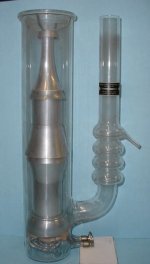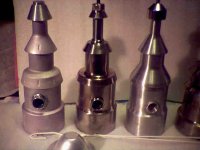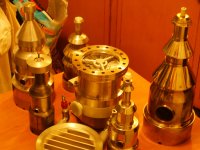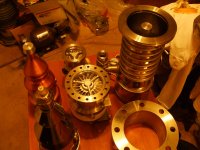Vacuum porn
Here is a nice see through pic of an early Distillation Products diffusion pump. They were one of the pioneers in diffusion pump development, and this diff pump model was used for evacuating many of the early Eimac tubes.
Then some pics of diffusion pump guts (jet stacks) and some small turbo pumps, diff pumps, etc.
The big jet stack is for a Varian VHS-4, then a medium stack for an Edwards E04, small stacks for Varian HS-2, Edwards Diffstak 63, L_H LeyboDiff 400, some Pfeiffer Turbos, 4" and 2.5", a CVC Teflon coated baffle for the VHS-4, the complete E04 and VHS-4 pumps, a flange adapter from the VHS-4 to ISO 160, a Veeco air cooled pump sitting on its black air plenum and fan.
Those VHS-4 (and VHS-6) stacks sometimes end up as art-techno lamp stands. If I end up with some extras, they might get used for vacuum tube air plenums on a tube amp. The tube would be visible through the ejector jet on the side of the stack.
Here is a nice see through pic of an early Distillation Products diffusion pump. They were one of the pioneers in diffusion pump development, and this diff pump model was used for evacuating many of the early Eimac tubes.
Then some pics of diffusion pump guts (jet stacks) and some small turbo pumps, diff pumps, etc.
The big jet stack is for a Varian VHS-4, then a medium stack for an Edwards E04, small stacks for Varian HS-2, Edwards Diffstak 63, L_H LeyboDiff 400, some Pfeiffer Turbos, 4" and 2.5", a CVC Teflon coated baffle for the VHS-4, the complete E04 and VHS-4 pumps, a flange adapter from the VHS-4 to ISO 160, a Veeco air cooled pump sitting on its black air plenum and fan.
Those VHS-4 (and VHS-6) stacks sometimes end up as art-techno lamp stands. If I end up with some extras, they might get used for vacuum tube air plenums on a tube amp. The tube would be visible through the ejector jet on the side of the stack.
Attachments
Last edited:
I just figured out that there is someone (or more likely several people) in Hong Kong that reads our posts and immediately calls the tube dealers in the US and buys the ENTIRE STOCK of the tubes we talk about.
Yes, this is a classic tactic. Back when jergens (I think) figured out how to sell soap in a pump dispenser, what did he do? He went to the only people who made those pumps at the time and bought out their entire production run for a year to keep the big companies from taking his market away.
There is a cottage industry there selling these reproductions abroad as kits and what have you.
As more "baby boomers" retire they are clearly expecting this market to expand, but that these baby boomers would rather buy the "classic amp" at the Big Blue Box store price and throw it out when they don't understand about changing tubes.
Bottom line, the only way to preserve your market is to define it clearly and reinforce your place in it. You can buy tubes upon tubes, but you'll have to sell them to your competitor later if you let them re-define the market for you.
Even the Big Blue box store can't compete against (name anyplace) because the people who won't go there don't like the experience and know enough to realize that their prices really aren't that good on the whole. But Big Blue still wins when the local tackle shop let's them redefine their market as price only consumers.
I'm not saying the price of these products doesn't have any elasticity in this space, so sometimes it comes into play depending on the remaining factors of convenience, accessibility and features. But, the degree of price comparing is definitely highly influenced by the way the market is developed.
The competitors overseas are banking that they can outprice the current market to drive cash flow. Just make it so that they have to do what they don't want to. Don't let them force you to do what you really shouldn't or else you are playing their game.
/End of rant. Sorry.
He went to the only people who made those pumps at the time and bought out their entire production run for a year
More recent example:
IBM created OS2 Warp, an excellent PC operating system in late 1994 before the computer CD rom was in everyone's PC. Before they could release it Microsoft bought up nearly every 1.44 MB 3.5 inch floppy disk on the planet. IBM released on 5.25 inch floppies (22 of them) which slowed them down enough for M$ to get Windows 95 out the door.
Later a clone of OS/2 was made (I'm not sure if it was an acquisition) but guess what Windows NT was based on?
You can't sell what isn't there (no amount of race stripe will make a car fly) but, good audio isn't a thing you buy, it's a skill you covet and build.
The best vendors online that are good at being what they do work very hard to help their customers cultivate that. See: www.sweetmarias.com they are a small operation, local relationships with the source of their product and have a deep connection with their buyers.
You can't sell what isn't there (no amount of race stripe will make a car fly) but, good audio isn't a thing you buy, it's a skill you covet and build.
The best vendors online that are good at being what they do work very hard to help their customers cultivate that. See: www.sweetmarias.com they are a small operation, local relationships with the source of their product and have a deep connection with their buyers.
More recent example:
IBM created OS2 Warp, an excellent PC operating system in late 1994 before the computer CD rom was in everyone's PC. Before they could release it Microsoft bought up nearly every 1.44 MB 3.5 inch floppy disk on the planet. IBM released on 5.25 inch floppies (22 of them) which slowed them down enough for M$ to get Windows 95 out the door.
That's an urban myth.
OS/2 Warp did, on the other hand, have a wicked bug that made it almost useless, which is why Windows 95 was able to leapfrog it in spite of being less impressive on paper: Half an operating system: The triumph and tragedy of OS/2 | Ars Technica.
-D
This is a bit off topic, but if MS hadn't STOLEN NT from DEC, they wouldn't have an OS at all.
It's one of the very few success stories ever at successfully suing MS,- not that it did them much good.
Intel was in on the act too, and destroyed DEC's superb 64 bit CPU, without even having to make a successful one to take its place, while MS slammed the door on DEC's Win2K offering.
Revenge doesn't make sweet reading, a great pity, because my version of win2k on DEC makes the WINTEL version look really the slow buggy crap it always was.
Few things give me more pleasure than to see Android, ARM & derivatives slowly destroy MS & Intel bit by bit, piecemeal, grinding them to dust.
It's one of the very few success stories ever at successfully suing MS,- not that it did them much good.
Intel was in on the act too, and destroyed DEC's superb 64 bit CPU, without even having to make a successful one to take its place, while MS slammed the door on DEC's Win2K offering.
Revenge doesn't make sweet reading, a great pity, because my version of win2k on DEC makes the WINTEL version look really the slow buggy crap it always was.
Few things give me more pleasure than to see Android, ARM & derivatives slowly destroy MS & Intel bit by bit, piecemeal, grinding them to dust.
Last edited:
That's a great article - and a good source. I stand corrected about my part. Interesting about the lesson learned. IBM, down and out was trying to be more of what that other company was and more. They didn't follow through. They didn't respond to the need. They missed the market, and ultimately didn't have a product that actually met the need.
Most people who buy tube related products, who can't afford a full blown point-to-point build by a local artist, what is their need?
Well, even a high end car dealership will let you take a used one for a spin.
For many, the right to drool is okay I guess. Others will want a taste. And if they're the right ones, that taste will be all it takes for them to want the real deal.
Trust me on this, I know what the real deal sounds like, and I don't even own one. But I can hear the difference side by side. So I'm building one, because that's what it takes. I'm willing to offer a cold one to the first organization/person who can reach the real market of regular people with products and branding that can become a household name that actually has credibility.
I am aware of "ridiculous low ball" pricing on some "tube" amplifiers. However, after seeing a number of legit designs, I know what I'm looking at when there just aren't enough components to really do what it says. The question is, why haven't we educated our consumer? *edited* I have zero commercial interests in this space, but if I did, I would play one on TV.
Oh the humanity. Lost in translation.
Again, sorry. /Rant off
Most people who buy tube related products, who can't afford a full blown point-to-point build by a local artist, what is their need?
Well, even a high end car dealership will let you take a used one for a spin.
For many, the right to drool is okay I guess. Others will want a taste. And if they're the right ones, that taste will be all it takes for them to want the real deal.
Trust me on this, I know what the real deal sounds like, and I don't even own one. But I can hear the difference side by side. So I'm building one, because that's what it takes. I'm willing to offer a cold one to the first organization/person who can reach the real market of regular people with products and branding that can become a household name that actually has credibility.
I am aware of "ridiculous low ball" pricing on some "tube" amplifiers. However, after seeing a number of legit designs, I know what I'm looking at when there just aren't enough components to really do what it says. The question is, why haven't we educated our consumer? *edited* I have zero commercial interests in this space, but if I did, I would play one on TV.
Oh the humanity. Lost in translation.
Again, sorry. /Rant off
Last edited:
That's an urban myth.
Maybe, maybe not. I know that I could not buy a 1.44 MB floppy for about 4 months in early 1995. I also was a beta tester for the OS2 3.0, 3.1 and 4.0 editions. Nobody from outside got into the lab in Boca, but IBM people came to me.
I worked in a "skunkworks" lab at Motorola about 1/4 mile north of Big Blue's campus. One of the developers and I were both attending masters degree classes at FAU, where we became friends, hence my PC was running OS2 with the "special sauce" cooked up in Big Blue's kitchen. I never had any real problems with the OS, but we did learn a lot about making a home built PC play nice on Motorola's workstation network which was populated with Sun Sparc's, Apollo's, HP Unix boxes, and even a few IBM Catia stations.
My friend from IBM was the person who told me the floppy disk story.
By this time (1996) OS2 had become a stable OS that worked well, and even I couldn't break, and Win 95 still sucked at functioning well in a networked environment with other OS'es. 95 and 98 would be banned from Motorola's network for security risk reasons.
The winds of change had already started blowing strong over South Florida's tech community. IBM was the first giant to fall. Not only the OS2 team, but the ENTIRE IBM Boca facility would close where over 10,000 people once worked, and the PC was born.....gone, now a multi tenant office park. The PC division, the personal printer division, and recently the small server division are all now part of the Chinese firm, Lenovo.
Motorola has closed all their plants in South Florida except, Plantation where I started and ended my 41 year career. Most of the "skunkworks" stuff including the Sparc stations, donated to FAU, the local college. Plantation once employed 5,000 people, now has about 250 and the building has been sold, again slated to become another office park. Ironically, Motorola's cell phone division is now also owned by Lenovo......So even the big guys are not immune to Chinese takeovers.
More OT:
The Chinese stole the cell phone technolgy too:
US charges six Chinese nationals for stealing trade secrets - BBC News
The Chinese stole the cell phone technolgy too:
US charges six Chinese nationals for stealing trade secrets - BBC News
This is a bit off topic, but if MS hadn't STOLEN NT from DEC, they wouldn't have an OS at all.
It's one of the very few success stories ever at successfully suing MS,- not that it did them much good.
Intel was in on the act too, and destroyed DEC's superb 64 bit CPU, without even having to make a successful one to take its place, while MS slammed the door on DEC's Win2K offering.
Revenge doesn't make sweet reading, a great pity, because my version of win2k on DEC makes the WINTEL version look really the slow buggy crap it always was.
Few things give me more pleasure than to see Android, ARM & derivatives slowly destroy MS & Intel bit by bit, piecemeal, grinding them to dust.
I would argue that Compaq's purchase of DEC and subsequent cancellation of Alpha in favor of Intel/HP Itanium were the driving reason behind Microsoft ending support for DEC processors. Why compile an OS version for an effectively dead architecture?
And yes, there are very marked similarities between VMS and NT due to the presence of Dave Cutler and other former DEC engineers - fairly common knowledge (and common practice at the time).
-D
We know now that Intel was scared rigid of the EV8 (21464), which was scheduled to drive the latest and greatest world's server up until 2025.I would argue that Compaq's purchase of DEC and subsequent cancellation of Alpha in favor of Intel/HP Itanium were the driving reason behind Microsoft ending support for DEC processors.
What came with "Alphacide" was the shameless corporate dismemberment of one of the USA's best IT assets, scamming off all the best staff in the world, and producing the pile of rubbish at Intel which nobody wanted and doesn't work.
The final corridor of shame is what became of Compaq, HP tru64 etc which presided over the entire (clearly externally financed) disaster.
Win2K on alpha was pulled 3 weeks before release so it was already working far better than Intel.
(I even have MS office alpha version on mine with dual screens, Lynx 24bit sound, the lot!)
Predatory capitalism always wins. 😡
It provides the customer with the worst possible technical solution, at the highest most unreliable support prices with the shortest term upgrade path vision. 🙄
I guess that's how they exported all the jobs to PRC in the end.
Only the Soviet Union managed to be more wasteful of intellectual resources.
That really takes some doing, when you consider they put their own space shuttle to rot outside in the snow and rain...
During 18 years, more than 1 million people in 1286 companies and 86 ministries and departments directly worked on the project.

The history of destruction of technical pinnacles is full of these tales over the last 50 years and we don't seem to be learning much from our own stupidity as a human race. 😱
Last edited:
Exactly. We now depend on 20 year old designs that were prompted by a continuous 6 month (Wall Street) design vision for capturing a market. Processors that are like Chevy Vegas with hyper levels of turbo upgrades. Software that is so riddled with design flaws and bugs that only virus's are guaranteed to work on it. Fastest to market ( even vaporware was invented here), with the cheapest stuff, wins the economic race, but sets the foundations for its eventual demise.
I was continually amazed by new computer programmer hires who were thrilled to work on what they thought were super advanced computer chips, with no idea of what elegant design really was.
Look at the Tokamak, it took the lead early on and became dominant. So instead of fusion being solved 50 years ago, we will be pouring trillions into a bottomless hole for the next 100 years. The number of stars in the Milky way galaxy, 10 to the 11th power, used to be called astronomical, until the national debt zoomed past it.
I was continually amazed by new computer programmer hires who were thrilled to work on what they thought were super advanced computer chips, with no idea of what elegant design really was.
Look at the Tokamak, it took the lead early on and became dominant. So instead of fusion being solved 50 years ago, we will be pouring trillions into a bottomless hole for the next 100 years. The number of stars in the Milky way galaxy, 10 to the 11th power, used to be called astronomical, until the national debt zoomed past it.
Last edited:
TBH I didn't know what a Vega was, until I looked it up.
I vaguely heard even the Acorn's low power abilities (like most British inventions) was an accident, then it slowly became ARM.
Now RISC has actually taken over the world and VPN/ARM/Asterisk on a little Raspberry Pi, can run your whole home PABX off a solar panel!
I vaguely heard even the Acorn's low power abilities (like most British inventions) was an accident, then it slowly became ARM.
Now RISC has actually taken over the world and VPN/ARM/Asterisk on a little Raspberry Pi, can run your whole home PABX off a solar panel!
Okay back to topic. This is one of my long term projects (among some). I came across some 12JN6 tubes where they were just too good to pass up.
4 RCA 12JN6's came in and wow! They looked better than I thought. these things must have been kept under somebody's bed out in the desert or something because even the boxes seem factory fresh.
All characteristics per the datasheet are supposed to be identical to 6jn6 except for heater plate voltage (however while the voltage is double, the current is roughly 1/2).
These 6JN6 tubes are getting a bit harder to come by... any reason why I couldn't build in a separate 12v .6a transformer for the heater circuit on this?
I figure I might as well ask now because these boards are so well known for their flexibility I'm planning something different than what I've seen so far.
My build will be a bit ah... unconventional in final appearance. No, not steampunk (yikes) just a bit more vertical than some of the horizontal texas sheetcake amplifiers I've seen so much of. (I like texas sheetcake).
I have a few requirements - (and yes I use a lot of negatives to exclude possibilities, so sorry for that.)
Refined, appealing in a greco roman proportional kind of way (golden ratio proportions)
No expensive looking visual elements.
Technically satisfactory from an implementation standpoint. Meaning there are no dodgy looking setups with regard to safety.
Craftsman-like construction, but not showy.
Must play well with a room's layout.
Can be set on a 15 inch deep shelf or mounted on a properly reinforced wall.
No limitation on material cabinet type. E.G. I've looked into even honed stone as a case material. (Cue the rock'n'roll innuendo)
Will have future expansion capability (room in the case for new elements or upgrades, or even have additional supplies and circuits available with a variety of options available)
This thing sounds like a swiss army knife. Unfortunately that means that it won't be amazing at one thing, but it should be serviceable in many ways. That's good because I intend to keep this one...
4 RCA 12JN6's came in and wow! They looked better than I thought. these things must have been kept under somebody's bed out in the desert or something because even the boxes seem factory fresh.
All characteristics per the datasheet are supposed to be identical to 6jn6 except for heater plate voltage (however while the voltage is double, the current is roughly 1/2).
These 6JN6 tubes are getting a bit harder to come by... any reason why I couldn't build in a separate 12v .6a transformer for the heater circuit on this?
I figure I might as well ask now because these boards are so well known for their flexibility I'm planning something different than what I've seen so far.
My build will be a bit ah... unconventional in final appearance. No, not steampunk (yikes) just a bit more vertical than some of the horizontal texas sheetcake amplifiers I've seen so much of. (I like texas sheetcake).
I have a few requirements - (and yes I use a lot of negatives to exclude possibilities, so sorry for that.)
Refined, appealing in a greco roman proportional kind of way (golden ratio proportions)
No expensive looking visual elements.
Technically satisfactory from an implementation standpoint. Meaning there are no dodgy looking setups with regard to safety.
Craftsman-like construction, but not showy.
Must play well with a room's layout.
Can be set on a 15 inch deep shelf or mounted on a properly reinforced wall.
No limitation on material cabinet type. E.G. I've looked into even honed stone as a case material. (Cue the rock'n'roll innuendo)
Will have future expansion capability (room in the case for new elements or upgrades, or even have additional supplies and circuits available with a variety of options available)
This thing sounds like a swiss army knife. Unfortunately that means that it won't be amazing at one thing, but it should be serviceable in many ways. That's good because I intend to keep this one...
4 RCA 12JN6's came in and wow! They looked better than I thought. these things must have been kept under somebody's bed out in the desert or something because even the boxes seem factory fresh.
Buy more, so you'll have a few spares. I've had a couple 6JM6's go a bit noisy on me.
jeff
I found an add on Craigs list for a bunch (about 500) of tv tubes for $35.
After I got it home I started counting and have nearly 73 6CB6s, plus some 21GY5, 21LG6, 21LR8, 21LU8, 21JZ8, 21JV6, plus a smattering of useless tubes.
After I got it home I started counting and have nearly 73 6CB6s, plus some 21GY5, 21LG6, 21LR8, 21LU8, 21JZ8, 21JV6, plus a smattering of useless tubes.
The 21JV6 is plug-in compatible with the 12JN6. Its got a bit bigger plate too.
If one wants to experiment with the bigger TV tubes, a lower primary Z than the 8K originally specified would be a good idea to keep B+ under control. George (Tubelab) typically uses a 3.3K primary for the big TV tubes. For the many intermediate 24 or 18 Watt size output tubes, 4K-5K likely would work well too. The TV tubes have a wide tolerance for voltage or current, so its just a matter of working with the B+ you have. A variable B+ supply would be another advantage. A multi-tap filament xfmr of sufficient rating for the various or bigger TV tubes would be useful then too. Typical filament voltages: 6.3V, 12V, 24V (drop-able to 21V, many 21V fil. tube models around), possibly 35/36V too. There is a cheap 26DQ5 around too. Point to point wiring will obviously give one the most flexibility for different tube pinouts.
If one wants to experiment with the bigger TV tubes, a lower primary Z than the 8K originally specified would be a good idea to keep B+ under control. George (Tubelab) typically uses a 3.3K primary for the big TV tubes. For the many intermediate 24 or 18 Watt size output tubes, 4K-5K likely would work well too. The TV tubes have a wide tolerance for voltage or current, so its just a matter of working with the B+ you have. A variable B+ supply would be another advantage. A multi-tap filament xfmr of sufficient rating for the various or bigger TV tubes would be useful then too. Typical filament voltages: 6.3V, 12V, 24V (drop-able to 21V, many 21V fil. tube models around), possibly 35/36V too. There is a cheap 26DQ5 around too. Point to point wiring will obviously give one the most flexibility for different tube pinouts.
Last edited:
I thought I’d post some pix and a few comments of my DCPP amp build. I’m a newbie with posting on forums, so my apologies in advance for any educate issues (coaching from moderator or veteran members welcome). This is my first DIY build. I’ve learned a lot and had tons of fun on the journey. My last audio projects were in the mid ‘80s – cramming 1,000 or watts of “boom” in anybody's car willing to let me have a go at it.
First I’d like to acknowledge Pete’s excellent design and commitment to helping newbies like me get into DIY tube audio. I searched for several months for a design that looked manageable for my 1st build. My initial criteria: lots of builds and forum support, PCB based (point to point looked intimidating for my first project), enough power to drive a fairly wide range of speakers and of course good sound. The engineer’s amplifier fit the bill nicely. I had a few questions during the build (6 months) and made a few… uh several rookie mistakes along the way. Pete kindly responded to my emails and eventually we got the amp up and running. Woo-hoo, I like it! I’d also like to thank George at Tubelab for indirectly inspiring me to do this build. I actually did LOL several times while reading this forum. George, you should seriously consider a 2nd career in comedy. “But seriously forks”, I am absolutely amazed at the collective knowledge of veteran members regarding all things tube on this forum. Thank you all for sharing your passion and knowledge.
1) The build began with a little reading. As my organizational behavior prof. told me back in 1990 “If you fail to plan, you plan to fail”. So I read the manual for the build while on vacation - or more accurately, the forum threads. Yes I killed a few trees.
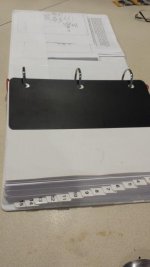
2) I masterminded a plan to hotrod the build for 100 wpc (thanks George). Went rouge and also decided to add additional inputs, selector switches, VU meters volume control, etc. Purchased all build components. Cut top plate to accommodate mods, but eventually realize I’m an idiot and should just follow the stock recipe to ensure the best probability of success (thanks George). “Set aside” superfluous parts, then re-cut a stock top plate.
3) After spending 6 hours meticulously polishing the “old” top plate, throw it in the trash. Spent another 5 hours polishing the “new’ top plate (I improved my technique a bit). I’m still not entirely sure why I did this, but it does look cool.
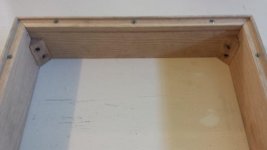
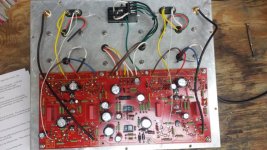
4) Next I cut the wood chassis and stuffed the board. I made every conceivable mistake possible (some really creative ones), then re-cut chassis and re-solder board… several times. I also pestered Pete with dumb questions along the way.
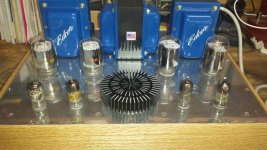
5) I finished the build in a late night frenzy. Then I took the untested amp to my friend’s house for the grand reveal. He has several pairs of exotic speakers that we agreed would be great for the initial sound check. The plan was to sip scotch, admire my genius and test our audiophile critical listening vocabulary (“the bass on the polks is a bit muddy and slightly laid back… notice the Snells reproduction on the mids is full but possibly too forward for my taste, blah blah blah)
6) After hooking up Tarun’s preamp and speakers, I flipped the switch and… nothing, silence, crickets chirping. I stared at my creation with dumbfounded horror and shame. We spent some time in vain trying to diagnose the problem but eventually gave up around midnight and drank the scotch instead.
7) After pestering Pete some more, I eventually got the amp up and running! One of the zeners was in backwards. I’m really enjoying listening to the amp, but won’t bother with my interpretation of how it sounds. I have come to understand this is very subjective. I love how it sounds! (and I’ll leave it at that).
I am very grateful for Pete’s email support along the journey – thanks again. I’m also thankful to the members who shared their DCPP amp builds and documented build issues and general “dos and don’ts”. I think I’m ready for my next build, probably a DHT SE amp. I looking hard at George’s published SE amp, but it looks like he may have some new design ideas... ready for prime time yet? I welcome member’s recommendations.
First I’d like to acknowledge Pete’s excellent design and commitment to helping newbies like me get into DIY tube audio. I searched for several months for a design that looked manageable for my 1st build. My initial criteria: lots of builds and forum support, PCB based (point to point looked intimidating for my first project), enough power to drive a fairly wide range of speakers and of course good sound. The engineer’s amplifier fit the bill nicely. I had a few questions during the build (6 months) and made a few… uh several rookie mistakes along the way. Pete kindly responded to my emails and eventually we got the amp up and running. Woo-hoo, I like it! I’d also like to thank George at Tubelab for indirectly inspiring me to do this build. I actually did LOL several times while reading this forum. George, you should seriously consider a 2nd career in comedy. “But seriously forks”, I am absolutely amazed at the collective knowledge of veteran members regarding all things tube on this forum. Thank you all for sharing your passion and knowledge.
1) The build began with a little reading. As my organizational behavior prof. told me back in 1990 “If you fail to plan, you plan to fail”. So I read the manual for the build while on vacation - or more accurately, the forum threads. Yes I killed a few trees.

2) I masterminded a plan to hotrod the build for 100 wpc (thanks George). Went rouge and also decided to add additional inputs, selector switches, VU meters volume control, etc. Purchased all build components. Cut top plate to accommodate mods, but eventually realize I’m an idiot and should just follow the stock recipe to ensure the best probability of success (thanks George). “Set aside” superfluous parts, then re-cut a stock top plate.
3) After spending 6 hours meticulously polishing the “old” top plate, throw it in the trash. Spent another 5 hours polishing the “new’ top plate (I improved my technique a bit). I’m still not entirely sure why I did this, but it does look cool.


4) Next I cut the wood chassis and stuffed the board. I made every conceivable mistake possible (some really creative ones), then re-cut chassis and re-solder board… several times. I also pestered Pete with dumb questions along the way.

5) I finished the build in a late night frenzy. Then I took the untested amp to my friend’s house for the grand reveal. He has several pairs of exotic speakers that we agreed would be great for the initial sound check. The plan was to sip scotch, admire my genius and test our audiophile critical listening vocabulary (“the bass on the polks is a bit muddy and slightly laid back… notice the Snells reproduction on the mids is full but possibly too forward for my taste, blah blah blah)
6) After hooking up Tarun’s preamp and speakers, I flipped the switch and… nothing, silence, crickets chirping. I stared at my creation with dumbfounded horror and shame. We spent some time in vain trying to diagnose the problem but eventually gave up around midnight and drank the scotch instead.
7) After pestering Pete some more, I eventually got the amp up and running! One of the zeners was in backwards. I’m really enjoying listening to the amp, but won’t bother with my interpretation of how it sounds. I have come to understand this is very subjective. I love how it sounds! (and I’ll leave it at that).
I am very grateful for Pete’s email support along the journey – thanks again. I’m also thankful to the members who shared their DCPP amp builds and documented build issues and general “dos and don’ts”. I think I’m ready for my next build, probably a DHT SE amp. I looking hard at George’s published SE amp, but it looks like he may have some new design ideas... ready for prime time yet? I welcome member’s recommendations.
- Home
- Amplifiers
- Tubes / Valves
- Posted new P-P power amp design
